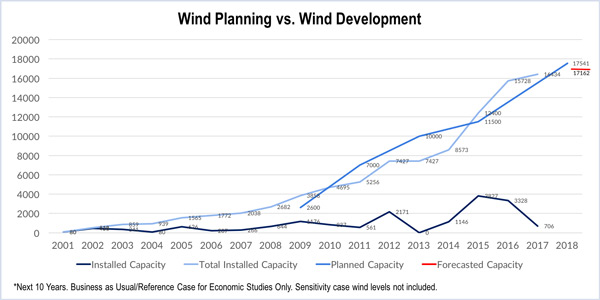By Tom Kleckner
DENVER — SPP’s on-again, off-again high-priority congestion study of the Texas and Oklahoma panhandles region is on once again following approval by the Board of Directors.
The study, ordered by the board in April to address historical congestion and frequently constrained areas (FCAs) in western Oklahoma and Texas caused by large amounts of wind energy, met pushback from the Markets and Operations Policy Committee three weeks ago. It was then revived with new direction by the Strategic Planning Committee later in that week. (See “Committee Gives Congestion Study New Life,” SPP Strategic Planning Committee Briefs: July 13, 2017.)
When SPP Vice President of Engineering Lanny Nickell presented a revised study scope to the board and members based on stakeholder feedback last week, he said he couldn’t recommend proceeding with the study.
“It’s to the point where the scope is so watered down now, I don’t think you’re going to get any value out of it,” Nickell said. “If you want to do a study, let’s do it right.”
Kelly Harrison, Westar Energy’s vice president of engineering, agreed, pushing for a more in-depth analysis that would provide that value to the market.
“If we could get some type of study to determine what it would take to move wind out of SPP — maybe to somebody who wants to buy that wind — it might send a price signal of what it would cost to move that wind with firm transmission,” he said. “Right now, [developers] don’t know what to pay. A longer study would give us a goal post and send a signal to the marketplace. We’re putting states in a bind with what I think is a pretty valuable resource.”
Nickell suggested a compromise by “tweaking” the scope of the 2018 integrated transmission plan near-term (ITPNT) assessment currently underway to include a summer scenario that models large amounts of wind. Stakeholders have taken the model out of previous studies because of concerns of “too much wind in the model for a summer-peak condition,” he said.
“It may make sense to reassert that model and use it in the 2018 ITP near-term, if evaluated against other needs,” Nickell said.
“That satisfies me!” board Chair Jim Eckelberger said.
Stakeholders agreed using the 2018 ITPNT would produce more timely results and reduce the drain on staff resources already engaged in regular studies. Staff’s workload is sure to be exacerbated should the Mountain West Transmission Group integration proceed. The ITPNT study is to be completed no later than April 2018. (See SPP, Mountain West Members Get Acquainted.)
“I don’t want anyone to forget why this began,” said West Texas-based Golden Spread Electric Cooperative’s Mike Wise. “The genesis of this discussion is based on … endemic congestion north and south of [Southwestern Public Service] and the continuation of a FCA south of there.
“Find me a solution. That’s what I’ve been asking for … for 10 years. I’m waiting for when the congestion goes away,” he said. “One of your members here is crying out. Please, please, let’s get this FCA taken care of, and don’t forget us.”
The Members Committee endorsed the revised high-priority study 10-8, with two abstentions. The board also voted in favor of the new study approach.
Work to improve SPP’s transmission congestion rights market will continue in the Market Working Group.
Separately, the board and Members Committee approved the expiration of the Export Pricing Task Force, which was charged with evaluating “mechanisms to establish equitable and not unduly discriminatory prices” to ship electricity in and out of SPP’s footprint. The task force was unable to provide a recommendation to handle the RTO’s growing wind energy (23 GW in the interconnection queue and not in service).
“We determined there are no really good solutions. There’s no silver bullet, so to speak,” said Wise, the group’s chair. “We asked for views on potential solutions that doesn’t, in the end, have SPP consumers footing the bill. The consumers that benefit from this wind are going to need to pay for the transmission.”
That was before AEP’s announcement it would build a 2,000-MW wind farm in western Oklahoma and send the energy eastward. (See related story, AEP to Spend $4.5B on Largest Wind Farm in US.)





